An early adopter offers his insights on the SimpliClear appliance system
by Clark Browne, DMD
For more than the past decade, every orthodontic supplier seems to have marketed ceramic brackets with coated wires to give the appearance of an aesthetic fixed braces system. The problem I quickly discovered with these systems is that the wire color does not match an individual patient’s tooth color. This made the wire “stand out” against the backdrop of the patient’s teeth, since it is nearly impossible to match a wire to an individual’s tooth color. There have also been problems with the coating chipping or wearing away, which significantly diminishes the aesthetic properties of the system. There was never a doubt in my mind that the status quo was unsatisfactory, and I looked to the future for a solution.
Late last year I came across a company called BioMers that claimed to have developed a “clear” wire called SimpliClear®. I attended a seminar where I learned that this innovation in wire came as a result of using nanotechnology. This new wire not only has a translucent appearance but, more importantly, exhibits the properties I require of an orthodontic wire. My practice treats a sizeable adult patient population, so I was intrigued at the potential of this new wire but was also skeptical, having dealt with many product disasters in my 30-year orthodontic career. I looked forward to assessing whether this SimpliClear product could indeed move teeth and withstand the abusive forces and vigors of the oral cavity. Always up for a new challenge, I said to myself, “Let the evaluation begin!”



Figures 1A-1C: A 44-year-old female patient presented with a Class II malocclusion. She had a severe crossbite from UL3 to UL7 with a mandibular shift and crowding.
A First Look

Figures 2A-2E: Treatment objectives include expansion of the upper arch to resolve the crossbite with possible extraction of UL4 after 6 months of treatment to achieve a Class I cuspid relationship.
Under visual examination, my initial thoughts were that SimpliClear definitely has a cosmetic edge on any other fixed product that exists on the market. The material is translucent, accommodating nearly any shade of enamel. Although impressed, I remained skeptical of its ability to get the job done from the orthodontic perspective. Could this be the next big innovation in orthodontics since the advent of NiTi archwires?
To investigate this question, I eagerly began treating patients immediately following the seminar. Product orientation took about an hour of my time. The protocol for submitting a case is similar to that of most aligner systems, including the submission of models, x-ray radiographs, intraoral photographs, and a prescription form. The next step is an electronic transfer of the setup of the customized indirect bonded ceramic brackets of your choice on a model with a proposed series of customized, translucent wires made specifically for each patient.
You are able to request expansion, constriction, curve of spee, individual control of teeth, and most other things you require for your patients’ treatment needs. Once you are satisfied that your treatment objectives will be met in terms of bracket placement, aligning, leveling, expansion, etc, you approve the fabrication of the customized appliance, including the indirect trays and translucent wires, which are then shipped to you. The process takes approximately 3 weeks from the time you ship the PVS impressions and prescription forms to final delivery to your practice.

Figure 3: The patient in the SimpliClear Custom Solution with .022 MBT prescription brackets and bondable tubes on upper and lower 6s and 7s.
Since the initial product offering, the company has made a number of improvements, including a digital case-management system, which has obvious advantages from a workflow perspective. Paper forms remain available, but the digital system, to me, is more convenient. I also now have the option of selecting direct or indirect bracket setup with my SimpliClear wires. My preference is to choose the indirect option, because it lets me optimize bracket position and thus maximize treatment efficiency. Another exciting option is the just-released STL file submission. I don’t have an in-house intraoral scanner, but I am finding myself considering purchasing one.
Handling the Wires
I found the learning curve with SimpliClear to be relatively short. All the normal fixed, labial appliance considerations are present with the one caveat: the wire handles differently, requiring a little more special care than a metal wire. The key is treating it gently during placement, using finger pressure when ligating it into the bracket slot. Although I use elastomeric ties to ligate the wire, you can also use tooth-tone ligature wire or self-ligating brackets. Tooth-colored posts and NiTi coil springs are also available.

Figures 4A-4E: The first wires. The upper initiates correction of the UR4s and UR5s (rotation and lingual inclination), together with slight expansion of the posterior to create space. The lower expands the arch and initiates the derotation and alignment of LL7.
I have had incidents of crazing (white spots) or breakage on occasion with the light-force wire (Align A) in the molar area, where the heaviest occlusal forces occur. I have overcome this problem by simply cutting the wire distal to the lower second bicuspids until heavier and more durable wires can be placed at a subsequent visit. If you need to expand the case and require anchorage early, another strategy is placing lace backs. If the molars are misaligned, the heavier wires will flex into the tubes with little effort. I usually indirect-bond both first and second molars at the initial bracket bonding appointment, and place wires to these teeth during the second or third visit.
The polymer composite wires should be cut with a sharp ligature cutter or small fingernail cutter at an angle of approximately 45º for easier insertion of the wire into the molar tubes. This tends to lessen the possibility of splaying the end of the wire. I do not recommend a distal hold cutter plier or any cutter with a crushing-type blow.
The wires can be placed with your fingers—no pliers are needed except maybe to begin the initial insertion in the molar tubes. If you prefer using pliers, BioMers does offer SimpliClear Weingart pliers with silicone rubber tips.

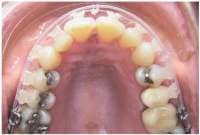

Figures 6A-6C: Upper wires create progressive arch development. Correction of the crossbite is complete. An overlay wire was used for 4 months to provide extra force for expansion along with crossbite elastics.

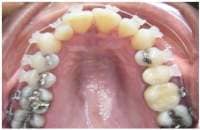

Figure 5A-5C: Upper wires create slight expansion to make space for UR2.
Once the wire is in place, you can cut the excess with a ligature cutter or a distal cutting plier, because the wire will normally be used only once. Although I have not found this to be a problem, you may further wish to place an elastomeric tie on the first molar to help prevent the smaller wires from sliding distally since they exhibit less friction than NiTi and stainless steel wires. You may also place a small drop of bonding material (such as Flowtain) on the distal tip of the wire, in lieu of a “v” bend, to prevent the wire from sliding distally through the buccal tube and sticking the patient.
My orthodontic clinical assistants had to adjust slightly to the unique handling properties of the wire, but they are at this point very comfortable using it.
Treatment-Planning
Treatment-planning with SimpliClear demands a well-thought-out progressive tooth movement sequence before the first wire is placed. In other words, you envision the end result and work toward it with each wire in terms of aligning, leveling, expansion, individual tooth movement, etc. One key advantage of this approach is that you avoid undesired tooth movement. Furthermore, your bracket placement is paramount in that it holds “the truth” as to how the teeth will align and occlude in the finishing stages of treatment.
These initial diagnostic and treatment thoughts are essential to achieving a wire sequence that is efficient when it means arriving at the optimal end result for each patient.
The treatment plan consists of a series of custom and standard preformed wires that are unique to every patient. You follow the wire progression plan, barring normal trouble such as broken brackets. I have taught my assistants to look for problems just as with any other labial bracket system. If we don’t observe any problems, we place the next wires in the progression. Once my assistants have worked with the wires a few times, this system is no more time-consuming for them than any other labial bracket system I have use d in my career. In fact, in most cases it is delegation-friendly.
This brings me to the point that treatment visits require less doctor time because the orthodontist is not rediagnosing the patient at each appointment, checking engagement of teeth, and rethinking individual tooth movement. I love how this has brought greater efficiency to my practice, allowing me to direct my attention on other, more value-added activities.
A Win-Win
In my estimation, the SimpliClear system appears to be a win-win situation for the patient and the orthodontist. Patients who I need to treat with fixed appliances in order to achieve the best results now have the option of a virtually invisible appliance system. At consultations, when I place typodonts on the table of different treatment options specific to their needs, my aesthetically conscious patients choose SimpliClear nine out of 10 times.
The other side of the win-win is the orthodontist side. My experience with SimpliClear has been very good, with only a few minor issues, such as wires breaking. My overall impression has been very positive due to the fact that this system performs as well or better than metal archwires. The heavier round and rectangular wires open the bite, torque the teeth, expand the arches, and rotate the larger rooted teeth as one expects from fixed appliances.
The wire system seems to be as efficient or more efficient than preformed metal wires, because each wire is custom-designed to carry out specific movements. This eliminates unwanted movements that increase treatment time and/or round-tripping of the teeth. The wire produces very light, continuous forces for movements such as torquing, and has less friction than metal wires. I have included images of a case I am currently treating to illustrate some of these benefits in a more practical manner.
On final reflection, I consider SimpliClear to be a home run. It has successfully joined two seemingly divergent treatment ideas—aesthetics for the patient and maximum control for the orthodontist—into one exceptional, exciting giant step forward for our orthodontic profession.

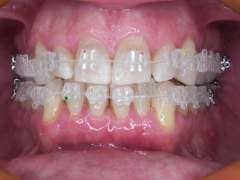




Before: An adult patient presented Class I. He was a bruxer with excessive wear on the incisal maxillary laterals. He had mild crowding in the mandibular arch and very mild crowding in the maxillary arch. The mandibular midlines were 1.5 mm to the left. The patient was fitted with the SimpliClear Custom Solution with .022 MBT brackets and bondable tubes on the 6s and 7s.


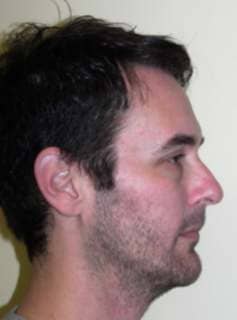


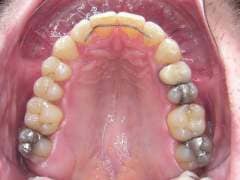
After: Records show the patient following 7.5 months of treatment. The crowding has been resolved and the midline adjusted.
Clark Browne, DMD, is in private orthodontic practice in Birmingham, Ala. He has been a part-time adjunct professor at UAB School of Dentistry’s Department of Orthodontics for 20 years. He is a diplomate of the ABO.










